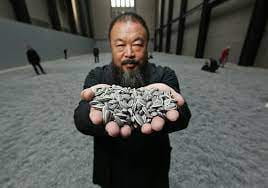 Xu Bing was born in Chongqing, in 1955 and grew up in Beijing. He went to the Central Academy of Fine Arts in Beijing in 1977, and went on to join the faculty and earned a master’s degree at the same school after completing his printmaking studies. In 1990 he was invited to the US as an honorary artist, and in 2007 he went back to China and was appointed multiple leadership roles at the Central Academy of Fine Arts, including supervisor of doctoral students, professor, and Vice President. Xu Bing creates all kinds of art from printmaking to large-scale room installations with an emphasis on using unique materials. Below is (the best close-up I could find of) a tiger rug made of cigarettes turned in two different directions, symbolizing humanities’ tendencies to fall into bad smoking habits. The ‘rug’ is made from over 500,000 individual cigarettes and weights more than 440lbs. Xu Bing has won numerous awards celebrating not only his artistic originality but also his transcendence of cultural boundaries, “bridging the divide between East and West and expressing his thoughts and realities in a visual language.” (quoted from the bio on his website)
Xu Bing was born in Chongqing, in 1955 and grew up in Beijing. He went to the Central Academy of Fine Arts in Beijing in 1977, and went on to join the faculty and earned a master’s degree at the same school after completing his printmaking studies. In 1990 he was invited to the US as an honorary artist, and in 2007 he went back to China and was appointed multiple leadership roles at the Central Academy of Fine Arts, including supervisor of doctoral students, professor, and Vice President. Xu Bing creates all kinds of art from printmaking to large-scale room installations with an emphasis on using unique materials. Below is (the best close-up I could find of) a tiger rug made of cigarettes turned in two different directions, symbolizing humanities’ tendencies to fall into bad smoking habits. The ‘rug’ is made from over 500,000 individual cigarettes and weights more than 440lbs. Xu Bing has won numerous awards celebrating not only his artistic originality but also his transcendence of cultural boundaries, “bridging the divide between East and West and expressing his thoughts and realities in a visual language.” (quoted from the bio on his website)
– Walter K.





 Zao Wou-Ki (赵无极), was a Chinese-French painter. He is known for is abstract paintings that combined traditional Chinese calligraphy with Western modernist techniques. His early works were heavily influenced by Chinese landscape paintings, but later incorporated elements of Western art, such as use of color and abstraction.
Zao Wou-Ki (赵无极), was a Chinese-French painter. He is known for is abstract paintings that combined traditional Chinese calligraphy with Western modernist techniques. His early works were heavily influenced by Chinese landscape paintings, but later incorporated elements of Western art, such as use of color and abstraction.




